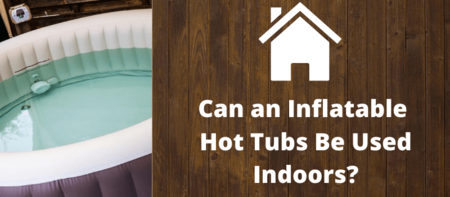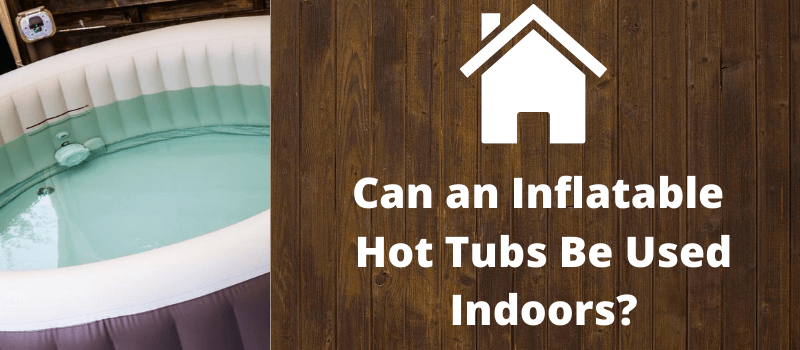
Many people buy an inflatable hot tub specifically for use outdoors so that they can make the most of their garden during the summer months. However, many others choose to buy their portable spa for use inside the home too. While some people choose to keep their inflatable tub indoors all the year round, others keep their outdoors during the summer and then drain it and bring it inside during the winter so they can maximise its use.
But is it really safe or a good idea to use your inflatable hot tub inside your home? I decided to look into it a little more closely.
So, can inflatable hot tubs be used indoors? Yes, inflatable hot tubs can be used indoors. You need to choose the spot inside your home carefully to ensure that the flooring and ventilation are suitable, and you’ll need to take a few extra safety precautions.
Getting the wrong location or set up inside for your inflatable hot tub can lead to all sorts of problems. You might even end up damaging your property or injuring yourself.
Read on to find out the right way to enjoy indoor hot tub relaxation!
Where Can I Set Up An Inflatable Hot Tub Indoors?
If you love the idea of enjoying a home spa but don’t want the hassle and expense of having a permanent acrylic hot tub fitted inside your property an inflatable hot tub might be just the thing for you. Inflatable hot tubs are portable and can be stored away and you can change their location as many times as you want.
So, what do you need to consider when setting up your inflatable spa both outdoors and indoors?
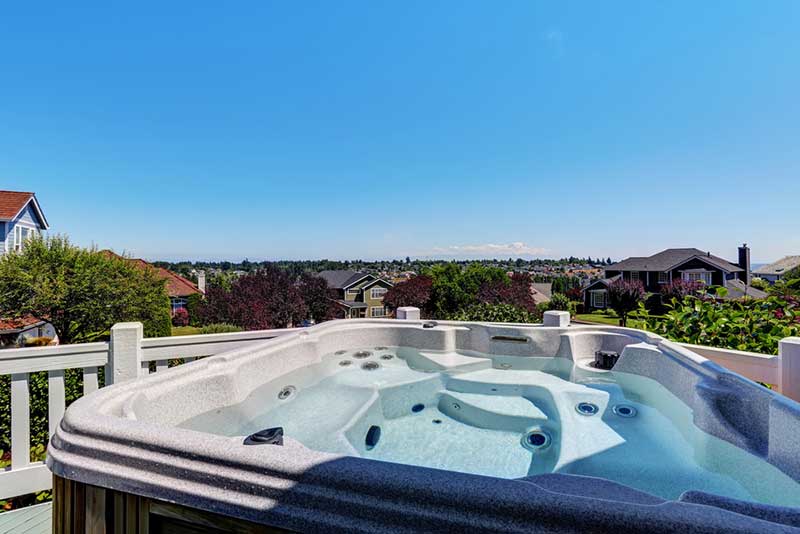
A flat level floor – No matter where you decide to set up your portable spa, you need to ensure that the surface is flat, sturdy and even. This will help to protect the base of the tub from potential damage due to sharp objects that could accidentally puncture the vinyl and cause a leak or a rip. Have a read of my post here on hot tub bases if you would like more detail.
Access to water – You also need to ensure that the space that you choose is close enough to a water supply so that the tub can easily be filled up. You won’t be able to move the tub once it is full of water as even an inflatable tub is heavy once the water is inside it. Therefore, you’ll need to find a spot to place your inflatable tub where a garden hose can reach from a tap so that you can easily fill it without any problems.
Access to power – Not only do you need to ensure that the tub is near a source of water, you also need to ensure that it is close to a source of power. If the power cable of the hot tub cannot reach a plug socket, you will need to move the tub closer. This is because you cannot use an extension cord with a portable hot tub since there could be a voltage drop that causes damage to the components of the tub’s pump motor. Outdoor hot tubs will need a specially installed outdoor electrical connection.
These are factors that apply whether you set up the tub indoors or outdoors. There are also some specific indoor considerations as well. It can be more challenging to set up an inflatable spa indoors since there will be fewer spaces inside the home that are suitable for placing it.
The floor surface – One of the first considerations to keep in mind when choosing a spot to place your portable spa in the home is the floor itself. Whenever you get into the hot tub or get out of it, water is going to drip off your body or over the sides of the spa itself.
This will lead to water dripping onto the floor. This won’t be an issue if the hot tub is placed outdoors. But if your inflatable tub is going to be set up inside, you need to consider the type of flooring that you have, particularly if the floor is carpeted or made of hardwood.
You may find that you have to constantly mop a hard floor made of linoleum, concrete, tiles or laminate since it could represent a slipping hazard. Meanwhile, a wooden floor could end up damaged because of excess water. A carpet could become moldy or affected by mildew due to the dampness seeping into its fibres.
The temporary solution to these problems is to place a waterproof sheet under the base of the hot tub before you fill it with water and then place some old towels around it on the floor to absorb the water and prevent accidental falls and slips.
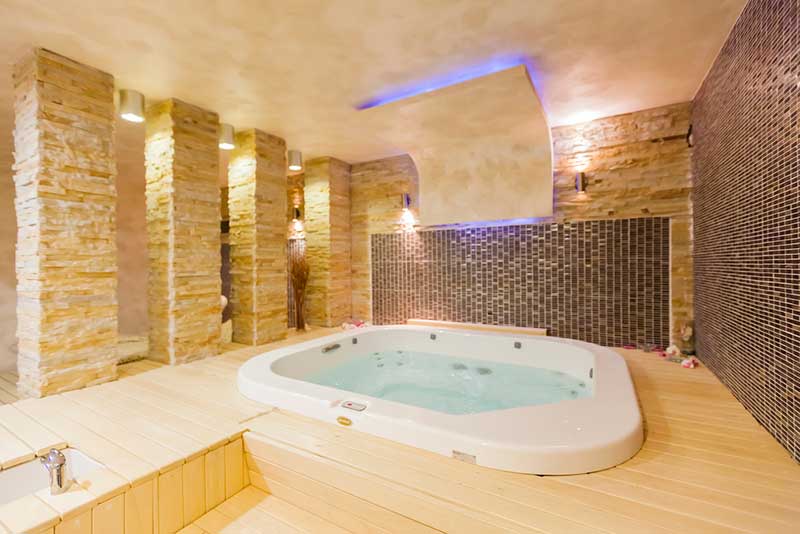
While this is a good temporary solution, it isn’t a very aesthetically pleasing one, so if your portable hot tub is going to be kept inside the home permanently, you may wish to consider purchasing a special non-slip mat to place under and around it for your own protection and for the protection of your property.
Steam and moisture problems – The next consideration when it comes to running your hot tub inside the home is steam. Hot tubs are designed to be capable of heating up the water inside them to as high a temperature as 40 degrees Celsius. This means that a lot steam is produced.
When the tub motor is switched on, the water is heating up, and the lid has been removed, the steam that is created can result in the room becoming damp. If you think of it as being similar to how your bathroom becomes steamy whenever you take a shower or bath you can see just how great a problem this could be without adequate ventilation.
To guard against the problems that dampness can cause such as mildew or mold, you need to ensure that you’ve chosen a room that has enough ventilation as well as doors and windows that can be kept open whenever the hot tub is in use. You might need to buy a ventilation unit to ensure that enough of the water vapor is removed.
The weight of the hot tub – The third consideration is the heaviness of the tub when the water and bathers are inside it. While it’s true that an inflatable hot tub is light when it is empty since the shell is only made from vinyl, once it has been filled up with water it is considerably heavier.
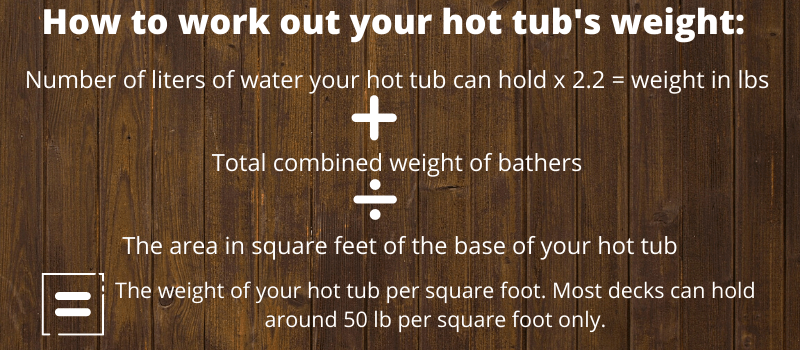
Then add to that the weight of three, four or more bathers and you can see how the weight can easily mount up, and all of that weight is only spread over a very small footprint. This means you need to ensure that you’ve chosen a room with flooring that is strong and sturdy enough to support this amount of weight. My post here on hot tubs on decking gives you more detail on how to work out how heavy your hot tub really is.
Drainage – Remember that you will also need to drain your hot tub of water. You do this by attaching a hose to the drain plug. You need to be able to run the hose out of the house and the hoe needs to drain lower down than the hot tub for the water to flow. For more details on where you can drain your hot tub water have a read of my post here.
How Do I Set Up My Inflatable Hot Tub Inside My Home?
Once you’ve borne all of the above considerations in mind, the next step is to actually set up the inflatable hot tub in the location that you’ve chosen. Remember that you cannot move the tub once it is full of water since it becomes exceptionally heavy, so ensure that you’ve chosen the right spot from the outset.
Read the manual – Before you do anything else, make sure that you’ve taken the time to read your owner’s manual thoroughly. Many people who buy an inflatable hot tub think that reading the manual is just a waste of their time, yet setting up an unfamiliar product without first reading through the instructions is never a good idea, especially when components like pumps and motors are involved.
It can be all too easy to make a serious mistake and this could cause a problem that costs you time and money to rectify. You could even end up invalidating your warranty if you aren’t careful. For example, if you try to connect one component to another that it isn’t supposed to fit to, it could result in damage or breakage.
If you try to incorrectly connect a cord and end up forcing it, it could become jammed and the whole hot tub could be broken in an instant. Since you wouldn’t be covered under the warranty since the error was your own fault, you’d need to buy a brand new one to replace the broken product. It’s clear, then, that reading the manual is always going to be a good idea and it will also help you to set up the tub more quickly and efficiently than you would ever be able to without first taking the time to check the procedure.
Unpack the hot tub – Once you’ve read the manual and are familiar with the procedure of setting the tub up as well as familiarised yourself with the various components and parts, the next step is to take the tub out of its packaging, lay it down in the spot where you wish to place it and then fasten the liner and inflation valve safely together.

Inflate the hot tub – The tub should then be inflated using the pump that is provided. Usually, this is the pump that also powers the motor that heats the water in the tub and that supplies the air for the bubbles. Plug in the pump and fix the inflation hose onto the pump and tub. Turn the pump on and then inflate the spa, inflating each portion consecutively if yours has more than one inflatable section. Again, you can refer to your instructions if you aren’t sure how to tackle this.
Attach the water filter – Next, put the water filter into its cover and fix it onto the outlet valve. This will usually be close to the interior bottom of your tub.
Fill with water – The next step is to fill up the tub with water. You should attach your regular garden hose to a nearby water source and turn it on so that the tub fills with water. Make sure that you fill it with sufficient water to cover the minimum fill level, but don’t overfill it so that the water level exceeds the marked maximum level.
Remember that you don’t have to fill the tub to its maximum level to enjoy a comfortable spa experience – your tub will heat more quickly and thus cost you less to run if you fill it to the minimum level. Don’t go below this level though or your tub won’t work properly.
Heat the water – Once the tub is filled with water, it’s time to start heating up the water. Find the heat button, press it, cover the tub with its lid and just wait until the water has reached its ideal temperature. Most inflatable hot tubs are capable of heating the water up to 104 degrees Celsius, but again, there’s no need to actually choose this maximum temperature. You can opt for a couple of degrees lower and still enjoy a comfortable spa experience while saving yourself time and money.
Add sanitizer – Check and adjust the PH levels of the water and add sanitizer. There are much more detailed instructions on how to do this in my Hot Tub Cleaning and Maintenance Made Simple post.
What Are The Benefits And Limitations Of Having My Inflatable Hot Tub Indoors?
There are both pros and cons of choosing to have your inflatable hot tub inside your home.
The major benefit is, of course, that you can continue to use the tub even when the weather is cold outside. In the UK, the winter weather can reach sub zero temperatures – far too cold to use an inflatable hot tub since most manufacturers recommend that their products aren’t used in temperatures that are below 4 degrees.
If your inflatable hot tub is kept indoors during colder weather, you can still hop into the water whenever you feel like it and won’t have to pack up your tub and keep it in storage until spring arrives.
Maintenance is pretty much the same when it comes to using your hot tub indoors or outdoors. In fact, it could even be easier to care for your hot tub when you keep it inside since it won’t get as dirty as it would if it was being kept in your garden.
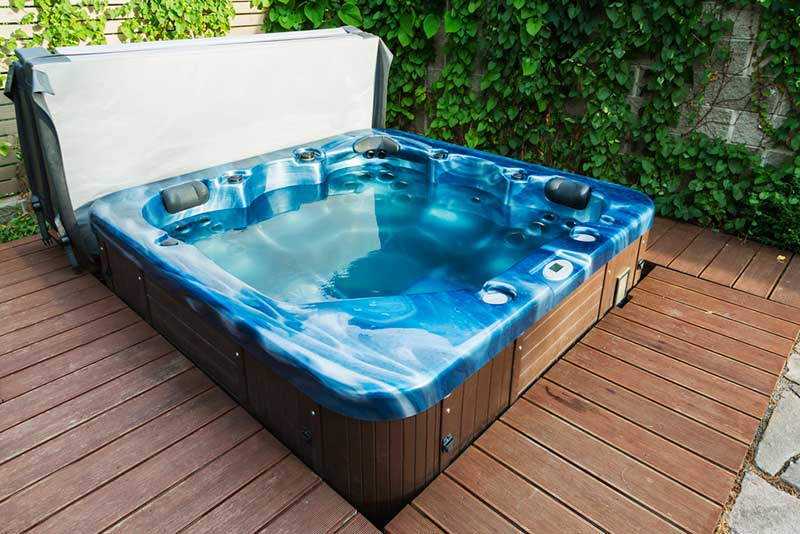
Of course, you’ll still need to clean it and cover it when you’re not using it to maximise its efficiency, and you’ll still have to add chemicals and check their levels so that the water won’t start to grow bacteria that could cause skin problems, but the cleaning tasks should be less onerous on an indoor spa.
There are a couple of limitations to though. Firstly, you’ll need to take more care when you’re getting into the tub and out of it. This is especially the case if children will be using the spa. Whereas they may want to splash and play in an outdoor hot tub, this just isn’t really possible when the tub is inside the home since puddles could all-too-easily form on the floor that could then be a slipping hazard and that would necessitate a lot of cleaning up.
Also, if you’ve got young children or inquisitive pets, you’ll need to find a way of securing the cover onto the tub since it would be possible for them to accidentally get into the tub and use it without supervision. This is much less likely to happen with an outdoor tub than an indoor one. In fact, there are a few things you should generally take into consideration when combining children with hot tubs – you can read more from the Pool and Hot Tub Alliance here.
Another issue is that you will still need to take the tub outdoors to clean it properly. Once it has been drained, it needs to be hosed down and scrubbed with soap and this is a task that would be extremely difficult inside your home. You will therefore, need to take the empty spa outside for thorough cleaning.
Related Questions
Is it possible to over inflate a portable hot tub? Unfortunately, yes, it’s certainly possible to overinflate your inflatable hot tub. In fact, this is a surprisingly common problem. If the tub is over inflated, excess strain is put on its seams.
When this happens, the seams can weaken and the result can be leaking or even rips that cause water to get out of the tub and into your home, damaging property and causing a host of issues. It’s also important to note that when an inflatable hot tub is filled up with water it needs to have a little give in its walls.
This is because the water will be very heavy. In fact, it could weigh as much as 2000 pounds. If the tub’s walls are too rigid because they contain too much air, the weight of the water will cause the inflatable tub’s shape to become deformed. This, in turn, can also place more stress on the seams and connectors, and so leakages can develop.
Do I still need to use chemicals in my inflatable hot tub if I keep it indoors? Regardless of whether you’re keeping and using your inflatable hot tub inside or outside the home, you still need to ensure that you have used the appropriate chemicals to keep it clean and hygienic for use.
All hot tub owners need to keep the water inside the spa tub sanitised and at the correct pH level. This will ensure that the tub continues to run properly while also protecting your health. Dirty water causes a host of unwanted health issues that could be as serious as Legionnaire’s Disease or as irritating as folliculitis.
When a hot tub of any kind, including inflatable models, is kept clean and disinfected with the correct use of chemicals like chlorine or bromine, it can give you hours of fun.
However, if it isn’t maintained properly and regularly, it can become a breeding ground for harmful organisms and bacteria that could make you very unwell. Make sure that you follow the instructions in your owner’s manual about the amount of chemicals to use in your tub and how often you should use them.

